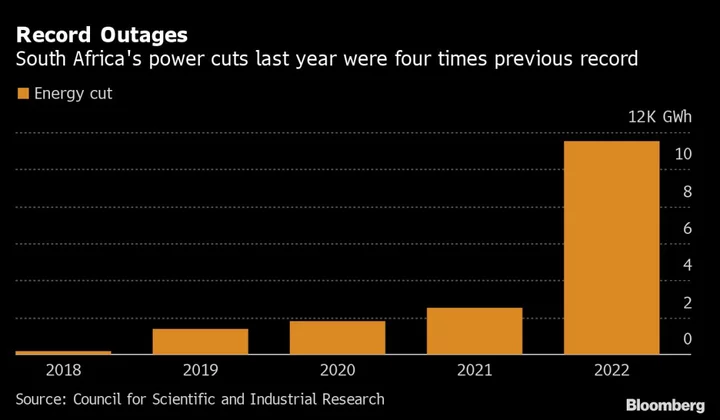South Africa will focus on fixing its dilapidated coal-fired power plants and the longer-term roll-out of at least 50 gigawatts of private renewable energy projects by the end of the decade to tackle crippling blackouts, according to senior officials in the nation’s presidency.
Africa’s most industrialized nation has been subjected to outages since 2008 because state utility Eskom Holdings SOC Ltd. is unable to meet demand for power from its old and poorly maintained plants. The power cuts have intensified since last year, despite repeated government assurances that it’s tackling the problem, and there are fears they could get even worse during the winter months when electricity demand increases.
Repairs to Eskom’s two newest power stations — Medupi and Kusile — and the completion of maintenance at its Koeberg nuclear plant will be prioritized, and the energy crisis should begin abating toward the end of the year, said Rudi Dicks, the head of the presidency’s project management office. Plans to retire some old coal-burning plants that are still performing well can also be delayed until the system has been stabilized, depending on the pace that private generation is added, he said.
“We don’t want to go on discussing loadshedding,” Dicks said in an interview at Bloomberg offices in Johannesburg, using the local term for power cuts. “Put me in front of a wall and shoot me” if significant strides aren’t made in addressing South Africa’s energy challenges, he said jokingly.
The electricity shortages have pushed up the cost of doing business, deterred investment and weighed on the rand and government bonds. With elections due to take place next year and opinion polls showing the ruling African National Congress is in danger of losing its national majority, South African President Cyril Ramaphosa is under pressure to show progress in turning the situation around.
A government decision in July to remove the cap on how much power private producers can generate without a license is one measure that’s gained traction. The project management office expects about 1,800 megawatts of private capacity to be added to the grid this year and substantially more thereafter.
Read more: How South Africa’s Blackouts Went From Bad to Worse: QuickTake
The breakout of Eskom’s transmission business into a separate unit, which should have its own board appointed by the end of June, is also seen as encouraging the development of additional plants.
“We’re moving very quickly from a centrally planned energy system to a decentralized liberalized electricity market,” Saul Musker, director of strategy and delivery support in the presidency, said in the interview. He envisions that between 50 and 60 gigawatts of renewable energy capacity will be added by 2030, which should be sufficient to replace about 24 gigawatts of output from coal-fired plants that are decommissioned, and meet additional demand, he said.
“In the end, the best, the least-cost optimal energy mix for the country is a huge amount of wind and solar and battery storage,” Musker said.
Connecting additional plants to the national grid will require an upgrade of the transmission system, which lacks adequate connections. The government’s National Energy Crisis Committee has identified 25 transmission projects which could unlock new grid capacity in the short term.
Eskom has sought help from Berlin-based company 50Hertz Transmission GmbH to assist with addressing South Africa’s transmission challenges as they are similar to those the Germans experienced in the early stages of their own renewable energy program, Dicks said.
Eskom has longstanding plans to break out its transmission unit to help ease access for private producers. The appointment of an independent board for the unit is expected by the end of the month, a key step toward making it fully operational as a stand-alone entity.
The utility has meanwhile set aside 72 billion rand ($3.8 billion) over the next three years to fund its transmission development plan.
50Hertz will help undertake an assessment of the grid and consider ways of boosting its capacity, and “we should really see at the end of this three-year period a lot more capacity from that grid-strengthening process,” Musker said.
Read more: South Africa Says Private Firms to Add 4 GW to Grid by End-2024
--With assistance from Amogelang Mbatha, Antony Sguazzin and Arijit Ghosh.
(Updates to contextualize quote in fourth paragraph, adds detail on transmission system upgrade is last two paragraphs.)

